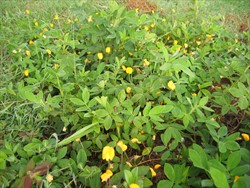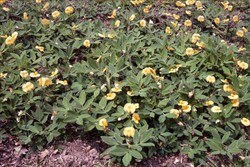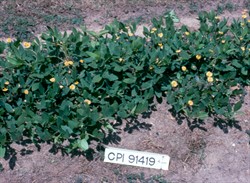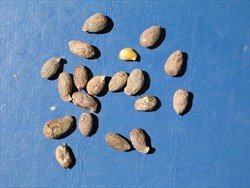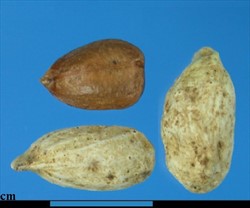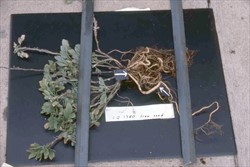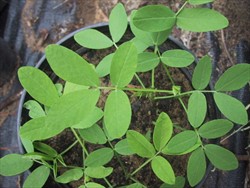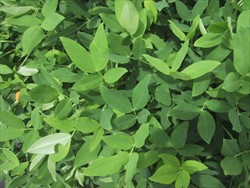Arachis paraguariensis
Tropical Forages
Arachis paraguariensis Chodat & Hassl.
Subordinate taxa:
Arachis paraguariensis Chodat & Hassl. subsp. capibarensis Krapov. & W.C. Greg.
Arachis paraguariensis Chodat & Hassl. subsp. paraguariensis
None listed in GRIN.
Krapovickas and Gregory (2007) list A. prostrata Benth. var. intermedia Chodat & Hassl. and A. Diogoi Hoehne forma submarginata Hoehne.
Family: Fabaceae (alt. Leguminosae) subfamily: Faboideae tribe: Dalbergieae section: Erectoides.
A long-lived perennial, with a deep, thick, somewhat fusiform taproot, to 12 mm in diameter, with thick, uniformly tapering branch roots.
subsp. paraguariensis: Main stem ±erect, 20‒85 cm tall; lateral branches ascendant/decumbent, internodes angular, to 7 cm long, short toward the apex of the branches, glabrous to villous, or with long silky hairs on the angles. Leaves tetrafoliolate with leaflets in pairs; stipule with surfaces pubescent to sub-glabrous, long silky hairs on the margins, sometimes with bristles on the fused part, adnate to the petiole for up to 20 mm, the free portion very acute, to 30 mm long and 2‒3 mm wide at the base; petioles to 30 mm long; and rachis ±10 mm long; both villous; leaflets oblong-lanceolate, acute, with smooth glabrous to sub-glabrous upper surface, and loose silky hairs, frequently with some bristles, on the lower surface; margins and prominent mid-vein with abundant long, silky hairs; distal leaflet pair to 62 mm long × 21 mm wide, basal pair to 60 mm long × 14 mm wide. Flowers borne densely above and below ground around the collar and lower nodes, as well as more sparsely along the branches, the latter only forming pegs if close to the soil; hypanthium 4.5‒12 cm long, villous; calyx bilabiate, 6‒11 mm long with silky hairs and some bristles on the outer surface; standard 14‒21 mm long and 16‒23 mm wide, entirely orange, orange-yellow, or orange with a small basal yellow spot and with lightly marked red lines on the upper surface; wings yellow. Fruit biarticulate, pegs 10‒75 cm long, growing horizontally, adventitious shoots have been observed developing from the ends of pegs; isthmus 2‒10 cm long; articles usually 15‒17 mm long and 7‒8 mm wide, pericarp smooth with a dense coat of diminutive hairs and curved apical beak. 5,000‒6,500 seeds/kg (not seed-in-pod).
subsp. capibarensis: tends to be lower-growing (to c. 20 cm) and with larger flowers (standard 15‒25 mm long, 18‒27 mm wide), than subsp. paraguariensis, with leaves elliptic, upper surface glabrous, and margins less conspicuously ciliate or hairy.
Description based on Krapovickas and Gregory (1994); translated by Williams DE and Simpson CE (2007).
Native:
South America: Brazil (Mato Grosso do Sul), Paraguay (Concepción, Amambay, Cordillera, Paraguarí)
Note: Subsp. paraguariensis occurs in the basin of the Paraguay River in SW Mato Grosso do Sul in Brazil, and in Paraguay (Amambay, Concepción, Cordillera, Paraguarí), while subsp. capibarensis appears to be limited to the south western extreme of Mato Grosso do Sul.Forage
Potential as a long term legume in intensively managed pasture in less fertile soils.
Environmental
Potential for soil-stabilising ground cover, by virtue of adaptation to low fertility soils, drought and grazing tolerance.
Other
Potential source of genetic resistance to early leaf spot caused by the fungus Cercospora arachidicola and to army worm attack by the lepidopteran larvae of Spodoptera litura for improvement of cultivated peanut (Arachis hypogaea L.).
Soil requirements
Occurs in soils ranging from deep sands to sandy, gravelly loams, dark sandy loams and silts, and red soils with rocky outcrops, with pH 4.5 to 6.0. In cultivation, some have proven adapted to hard setting yellow and brown duplex soils and light clays.
Moisture
Mostly found in well drained, often dry soils in an area receiving 1,200 to 1,500 mm average annual rainfall. Has persisted in cultivation in areas with an average annual rainfall of 700 to 900 mm, but does not perform as well in areas of >1,200 mm.
Temperature
Originates from between 20º S and 25º30' S, and from 100 to 480 m asl, regions with average annual temperatures of about 23‒25 ºC. Various accessions have performed well in the subtropics with average annual temperature of 18–23.5 ºC. Tops are burnt by frost but plants recover with onset of warmer weather.
Light
Moderately shade tolerant, being found largely in wooded savannah (cerrado, Chaco) and on the margins of densely wooded savannah (cerradão).
Reproductive development
Flowers throughout the year at 26º S, except during winter. Flowers borne densely above and below ground around the collar and lower nodes, as well as more sparsely along the branches, the latter only forming pegs if close to the soil. Most pods are found at 2‒8 cm depth on pegs that are longer than in other species.
Defoliation
Extremely tolerant of frequent, low grazing. When grown in association with sward-forming grasses, regular defoliation may be necessary for persistence.
Fire
Fire has little effect on stands, mature plants regrowing from buried crowns, and new seedlings emerging in adjacent open ground.
Establishment
Seed-in-pod is normally sown at 10‒20 kg/ha, using the higher rate for a denser stand in the establishment year. Seed should be placed no deeper than 8 cm. One accession (CPI 91419) nodulates effectively with Bradyrhizobium strain NC 92 (CB 3094 for A. hypogaea) and CIAT 3101 (QA 1091, CB 3125 for A. pintoi). It is important to limit grass competition in the early stages necessitating a clean seedbed and early grass defoliation. Seedlings establish readily and can be grazed within 6‒8 weeks of emergence.
Fertilizer
No data available. However, in its area of origin and in Australia, it appears adapted to soils of relatively low fertility.
Compatibility (with other species)
Best performance in open stands of other species.
Companion species
Grasses: Bothriochloa bladhii, B. insculpta, Digitaria eriantha, Heteropogon contortus.
Legumes: Aeschynomene falcata, Chamaecrista rotundifolia, Listia bainesii, Stylosanthes scabra, S. seabrana.
Pests and diseases
Chlorogenic acid and rutin, phenolic acid esters produced in the leaves, inhibit development of larvae of the moth, Spodoptera litura. A. paraguariensis is resistant to early leaf spot caused by Cercospora arachidicola, but some lines are susceptible to root-knot nematode, Meloidogyne javanica Race 3, an important nematode parasite of groundnut (Arachis hypogaea). Highly resistant to attack by tobacco armyworm, the larvae of Spodoptera litura (Lepidoptera: Noctuidae), an important pest of groundnut.
Ability to spread
Spreads very slowly by virtue of seedlings developing at the ends of pegs. This mostly amounts to about 10 cm/yr in a dry environment, but may be greater depending on soil conditions and plant genotype.
Weed potential
Nil.
Dry matter
In the humid subtropics, harvesting at ground level every 6 weeks has produced annual yields of 0.3–2.4 t/ha DM. It is unlikely that much higher yields would have been obtained under more lenient management.
Animal production
No data available
Diploid, 2n = 20 for both subspecies. Various intra and inter-sectional hybrids have been produced in laboratory studies. Sterile, spontaneous sub-rhizomatous hybrids with A. glabrata (section Rhizomatosae, 2n = 40) have appeared in nursery plots. Hybrids have been obtained with the incompatible species, Arachis hypogaea, using embryo rescue and tissue culture techniques. May be a source of resistance to tobacco armyworm (Spodoptera litura), an insect pest that has developed resistance to insecticides (see “Other comments”). Tetraploids induced through colchicine treatment could be used in overcoming hybridization barriers due to ploidy differences within Arachis. See Aina et al. (2012) in "Selected references".
No information available. However, A. paraguariensis is similar in many respects to A. kretschmeri (section Procumbentes), and seed production suggestions for that species may be appropriate:
"Pegs are not persistent and pods are released soon after maturity. Accordingly, seed must be separated from the soil mass, and is therefore best produced in friable, sandy soil. Crops are initially sown in rows, 50 to 75 cm apart, with a sowing rate of 30– 40 kg/ha seed-in-pod, roughly equivalent to 1 seed every 10 cm. There is usually sufficient seed remaining in the ground for regeneration of subsequent crops. Crops should be kept as weed-free as possible, since seed yields can be markedly reduced by the presence of weeds. Seed is produced throughout the growing season, with flowering terminating at the onset of cold and/or dry conditions. Seed is harvested during the dormant season by rotavating the area and sieving the seed from dry soil. Cultivation when soil is moist can lead to germination of seed and loss of quality".
Seed production varies with plant genotype and environmental conditions, especially soil fertility.
No information is available on herbicide tolerances. However, consideration could be given to the cautious use of chemicals used in the cultivation of Arachis hypogaea, A. glabrata and/or A. pintoi. Pre-plant or pre-emergent herbicide applications are often more effective and economical than post-emergent applications.
S-metolachlor or pendimethalin are successful pre-emergents, and fluazifop and sethoxydim post-emergents (grass control) in the former. Imazapic can be used prior to flowering for control of certain grasses and broad-leafed weeds. A. glabrata is tolerant of pre-emergence herbicides, trifluralin and vernolate, and post-emergence herbicides, alachlor, dinoseb, bentazon, 2,4-D, 2,4-DB, sethoxydim and fluazifop-butyl, but susceptible to metsulfuron methyl and glufosinate. A. pintoi has been shown to be tolerant of acifluorfen, bentazone, 2,4-D, 2,4-DB, fluazifop-butyl, and sethoxydim, but susceptible to metsulfuron-methyl and glufosinate.- Drought tolerant.
- Wide soil adaptation.
- Very persistent under grazing.
- High quality forage.
- Not fertility-demanding.
- Low forage yields.
- Difficult to harvest seed.
Aina, O., Quesenberry, K. and Gallo, M. (2012) In vitro induction of tetraploids in Arachis paraguariensis. Plant Cell, Tissue and Organ Culture (PCTOC) 111:231–238. https://doi.org/10.1007/s11240-012-0191-0
Gimenes, M.A., Lopes, C.R. and Valls, J.F.M. (2002) Genetic relationships among Arachis species based on AFLP. Genetics and Molecular Biology 25:349–353. doi.org/10.1590/S1415-47572002000300017
Krapovickas, A. and Gregory W.C. (1994) Taxonomía del género Arachis (Leguminosae). Bonplandia 8:1–186. doi.org/10.30972/bon.81-43559
Krapovickas, A. and Gregory, W.C., transl. by Williams, D.E. and Simpson, C.E. (2007) Taxonomy of the genus Arachis (Leguminosae). Bonplandia 16(Supl.):1–205. doi.org/10.30972/bon.160158
None released.
CPI 91419, (PI 338297, HLKHe 565). ssp. capibarensis. Origin Mato Grosso do Sul, Brazil (21º45' S, 200 m asl, rainfall c. 1,200 mm/yr). Has persisted and spread under often-heavy grazing on infertile and moderately fertile soils in the sub-humid subtropics of Queensland, Australia. Has also persisted in short-term evaluation on fertile clay soil in the uplands of Eritrea. Not progressed because costs of seed production too high for development to be economical.
CQ 1780. ssp. paraguariensis. Origin uncertain, but probably CPI 8987-8, introduced as A. diogoi from the Agricultural Experiment Station, Deodoro, Brazil. Planted about 1937 on a black clay soil at Fitzroyvale on the Tropic of Capricorn near Rockhampton in central Queensland. Described in a report at the time as “native to prairies in the state of
